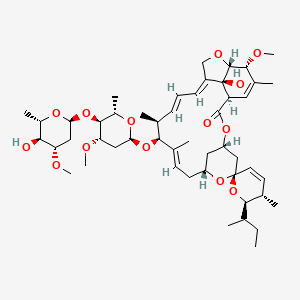| MeSH term | MeSH ID | Detail |
|---|---|---|
| Parasitic Diseases, Animal | D010273 | 1 associated lipids |
| Lice Infestations | D010373 | 9 associated lipids |
| Poisoning | D011041 | 9 associated lipids |
| Scabies | D012532 | 2 associated lipids |
| Trichostrongyloidiasis | D014252 | 7 associated lipids |
| Trichostrongylosis | D014253 | 5 associated lipids |
| Strongylida Infections | D017206 | 5 associated lipids |
| Tuberculosis, Multidrug-Resistant | D018088 | 6 associated lipids |
| Neurotoxicity Syndromes | D020258 | 34 associated lipids |
Avermectin A1a
Avermectin A1a is a lipid of Polyketides (PK) class. Avermectin a1a is associated with abnormalities such as Ataxia with vitamin E deficiency, Strongyloidiasis, Congenital Transposition, Gigantism and Onchocerciasis. The involved functions are known as DNA Binding, Anabolism, Insertion Mutation, Process and physiological aspects. Avermectin a1a often locates in Chromosomes, Membrane, Clone, soluble and Tissue membrane. The associated genes with Avermectin A1a are Polypeptides, oxytocin, 1-desamino-(O-Et-Tyr)(2)-, Gene Feature, Genome and Gene Clusters. The related lipids are Propionate. The related experimental models are Mouse Model.
Cross Reference
Introduction
To understand associated biological information of Avermectin A1a, we collected biological information of abnormalities, associated pathways, cellular/molecular locations, biological functions, related genes/proteins, lipids and common seen animal/experimental models with organized paragraphs from literatures.
What diseases are associated with Avermectin A1a?
Avermectin A1a is suspected in Ataxia with vitamin E deficiency, Gigantism, Strongyloidiasis, Congenital Transposition, Onchocerciasis, Tropical Disease and other diseases in descending order of the highest number of associated sentences.
Related references are mostly published in these journals:
| Disease | Cross reference | Weighted score | Related literature |
|---|
Possible diseases from mapped MeSH terms on references
We collected disease MeSH terms mapped to the references associated with Avermectin A1a
PubChem Associated disorders and diseases
What pathways are associated with Avermectin A1a
There are no associated biomedical information in the current reference collection.
PubChem Biomolecular Interactions and Pathways
Link to PubChem Biomolecular Interactions and PathwaysWhat cellular locations are associated with Avermectin A1a?
Visualization in cellular structure
Associated locations are in red color. Not associated locations are in black.
Related references are published most in these journals:
| Location | Cross reference | Weighted score | Related literatures |
|---|
What functions are associated with Avermectin A1a?
Related references are published most in these journals:
| Function | Cross reference | Weighted score | Related literatures |
|---|
What lipids are associated with Avermectin A1a?
Related references are published most in these journals:
| Lipid concept | Cross reference | Weighted score | Related literatures |
|---|
What genes are associated with Avermectin A1a?
Related references are published most in these journals:
| Gene | Cross reference | Weighted score | Related literatures |
|---|
What common seen animal models are associated with Avermectin A1a?
Mouse Model
Mouse Model are used in the study 'Anticonvulsant and adverse effects of avermectin analogs in mice are mediated through the gamma-aminobutyric acid(A) receptor.' (Dawson GR et al., 2000).
Related references are published most in these journals:
| Model | Cross reference | Weighted score | Related literatures |
|---|
NCBI Entrez Crosslinks
All references with Avermectin A1a
Download all related citations| Authors | Title | Published | Journal | PubMed Link |
|---|---|---|---|---|
| Alves SN et al. | [Susceptibility of Culex quinquefasciatus larvae to different insecticides]. | 2011 Jul-Aug | Rev. Soc. Bras. Med. Trop. | pmid:21860896 |
| de Macedo DM et al. | [Post-embrionic development of Stomoxys calcitrans (Linnaeus,1758) (Diptera: Muscidae)feed in feces of treated bovines with different avermectins]. | 2005 Apr-Jun | Rev Bras Parasitol Vet | pmid:16153344 |
| Ostlind DA and Cifelli S | Efficacy of thiabendazole, levamisole hydrochloride and the major natural avermectins against Trichostrongylus colubriformis in the gerbil (Meriones unguiculatus). | 1981 | Res. Vet. Sci. | pmid:7323472 |
| Lonneux JF et al. | Antibody response after treatment in cattle infected with Psoroptes ovis. | 1997 Jul-Aug | Res. Vet. Sci. | pmid:9368957 |
| Lankas GR et al. | Placental P-glycoprotein deficiency enhances susceptibility to chemically induced birth defects in mice. | 1998 Jul-Aug | Reprod. Toxicol. | pmid:9717696 |
| Gianelli L et al. | Mass spectrometry of avermectins: structural determination of two new derivatives of Ivermectin B(1a). | 2000 | Rapid Commun. Mass Spectrom. | pmid:10918377 |
| Turnipseed SB et al. | No-discharge atmospheric pressure chemical ionization: evaluation and application to the analysis of animal drug residues in complex matrices. | 2006 | Rapid Commun. Mass Spectrom. | pmid:16541409 |
| Turnipseed SB et al. | Confirmation of avermectin residues in food matrices with negative-ion atmospheric pressure chemical ionization liquid chromatography/mass spectrometry. | 1999 | Rapid Commun. Mass Spectrom. | pmid:10204245 |
| Ikeda H et al. | Organization of the biosynthetic gene cluster for the polyketide anthelmintic macrolide avermectin in Streptomyces avermitilis. | 1999 | Proc. Natl. Acad. Sci. U.S.A. | pmid:10449723 |
| Rohrer SP et al. | Photoaffinity labeling of avermectin binding sites from Caenorhabditis elegans and Drosophila melanogaster. | 1992 | Proc. Natl. Acad. Sci. U.S.A. | pmid:1315055 |
